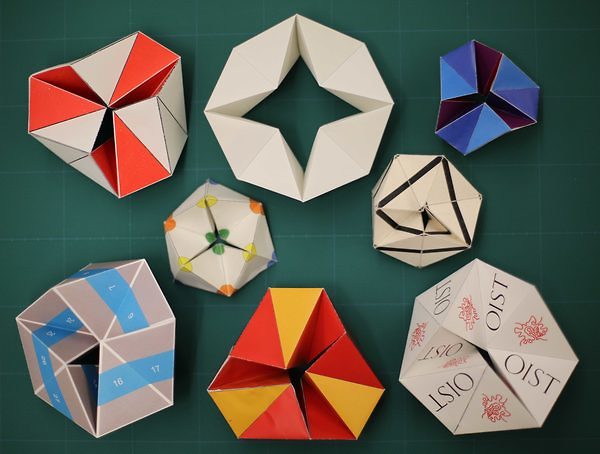Most people are familiar with a möbius strip, literally a surface with a twist: a long continuous object with only one side. But what about a möbius shape that is instead made up of several parts hinged together?
A team of scientists led by Johannes Schönke and Eliot Fried at the Okinawa Institute of Science and Technology Graduate University (OIST) have unveiled a new class of such shapes. Möbius kaleidocycles are made up of a number of rigid components linked into a ring, and they can be continuously turned in on themselves – but only in one direction. The paper published in December 2018 in the Proceedings of the National Academy of the Sciences (PNAS) details a variety of configurations explored through simulation and 3D printing, identifying the ideal angles and numbers of components to create these funky shapes. Anyone can test their findings by making one themselves – all it takes is paper, patient folding, and a little glue!
One may wonder why these highly-respected scientists are being paid to do origami. The answer lies in the specialness of linkages, the mobile joints between rigid components (like a door hinge, or the elbow joint in an arm). Objects that fold and change their shape are often enormously more useful than objects that can’t: imagine if umbrellas could only be carried in their fully expanded glory instead of collapsed into a smaller size.
Objects that fold and change their shape are often enormously more useful than objects that can’t.
Creating a linked ring with a single degree of freedom, meaning it has one-directional movement, may be the key to a myriad of technological innovations. These shapes can be applied to the creation of synthetic chemicals called möbius molecules that exhibit novel electronic properties. Deployable structures such as solar panels on a spacecraft can be optimized to unfold from compact storage into their final form. Even robotics can benefit, allowing bots to change their size and shape to fit into tight spaces.
Research on new shapes and configurations lies at the nexus of mathematics and art: not only do linkages illuminate exciting prospects in engineering, but they can also create objects of mesmerizing beauty.
Proceedings of the National Academy of Sciences (2018). DOI: 10.1073/pnas.1809796115
Image source: OIST

